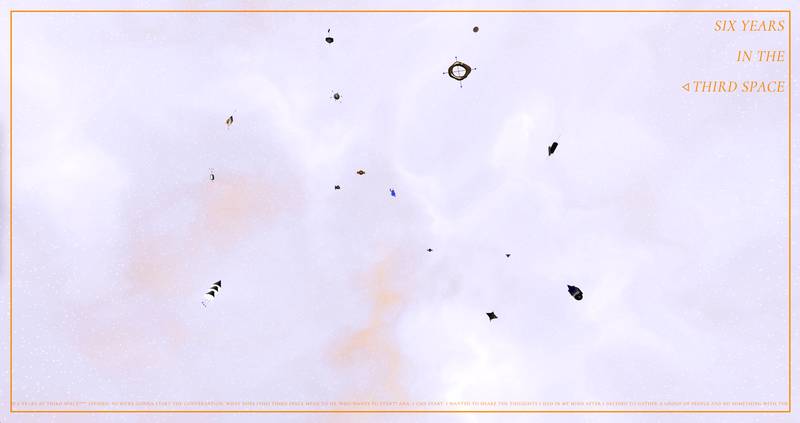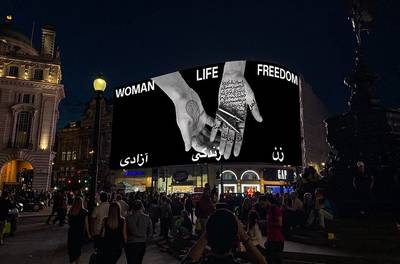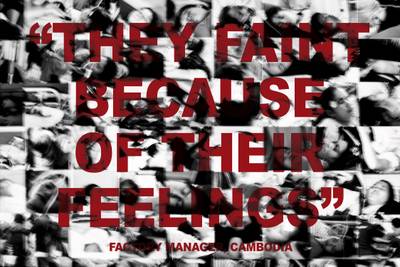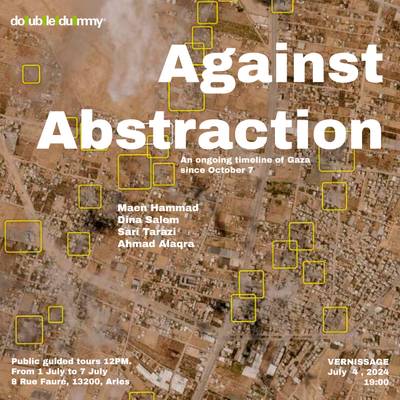

Online Publication, Six Years in (the) Third Space (Third Space Collective – Elina Nissinen, Sepideh Rahaa, Martina Miño Pérez, Rosamaría Bolom & Ana Gutieszca.)
Shubhangi Singh’s practice as a visual artist and filmmaker responds to contemporary politics and the interconnectedness of production and reproduction of popular and everyday material. She often draws upon the empirical as well as existing recorded knowledge to address movement, identity and queries related to the cultural and social reality of the feminine and its negotiations with the public sphere. Singh is the co-founder of New City Limits, an initiative to facilitate creative viewing and practice in Navi Mumbai, India and she currently lives and practices in Helsinki.
Online Publication Review: Six Years in (the) Third Space (Third Space Collective – Elina Nissinen, Sepideh Rahaa, Martina Miño Pérez, Rosamaría Bolom & Ana Gutieszca.)
Web design/programming: Martina Miño Pérez & Sébastien Piquemal
Against a smooth, pastel purple backdrop, satellites emerge, intercept the user’s cursor and zoom about as they navigate the website. It’s a trip to the steampunk cosmos imaginations –– something I would have never instantly pinned as Third Space’s aesthetics but once I am there, I feel invested in it. The disordered transgression begins to reveal itself to the visitor.
Arriving at a particular watershed moment, Six years in the Third Space is an online publication that earmarks a key milestone in the course of the physical space existing in the city since 2013. It embodies and carries forward the hybridised in-betweenness which the physical space attempts to live by1. Informed by a large network of collaborators and shared stories, the collection becomes a living organism, an orbiting satellite –– autonomous and yet, carrying the identity of the body that it takes after.
The publication marking six years of the space’s presence in Helsinki holds within it a host of material –– 14 different contributions (artworks, essays, exchanges, conversations and texts) as well as 6 aural pieces and soundscapes –– a terrific nod to Third Space’s bona fide underground alt music haven, Sound Room. Launching just as the world was settling into the lull of a now somewhat familiar drone, the publication looks to do more than simply celebrate a number of years that the space has existed in the city for. It is presented as an artifact of collaborative practices; a collection of stories that aim to reflect on experiences from collective workings, failings and learnings. Not necessarily in that order.
Creative labor is a process; and the cultural sector still has a lot of histories to open up, learn from, and overcome.
MYTHOLOGICAL MIGRATIONS: ON COLLABORATION, ORGANIZATION, AND PRODUCTION
ABDULLAH QURESHI & DANAI ANAGNOSTOU
Third Space is a result of a group of individuals seeking a place to share and to come together in a city that they may not all have been born in but have come to call home. And then, to further open that shared, amorphous space to others who exist(ed) on the margins of access to resources and opportunities. Third Space is a draft, a location for encounters and actions that the individuals created when one wasn’t otherwise available to them.
The physical gallery that continues to operate outside of the standard Finnish rent model2 is a site that has resisted the force (and the temptation) of this nefarious and oppressive economic model while also nurturing the values of equity, experimentation and intimacy. It is pivotal here to state that the personality of the gallery space is not entirely separate from the identity of the Third Space Collective that steers it. The two identities are, in fact, entangled in sometimes tense and in other times, wonderful ways. It is these individuals –– past members as much as the current –– who with their varied, transcultural backgrounds, experiences and artistic practices have recognised (and built upon) the value of fostering an alternate space that thrives in the same unclassifiable in-betweenness as its members. By embodying the principles of the Third Space and related theories that it takes after, the space may also reproduce (or expose) some of the tangled sentiments, the cultural deposits as well as the critiques that this concept lays bare.
It isn’t some unified glub of gooberooum. A cakataota in hoppitihop. No. On the contrary, the Third Space is a complex place of hybridity and mongrel ethos, informed by the presence of various, albeit specific conditions.
The notion of the Third Space, as we know, is notorious for how elastic the idea can get. How far it can be bent out of shape. This exact characteristic is also its very strength, since the central argument of the theory opposes being implied as a homogeneous whole. A Third Space does not exist solely as an alternative to the binary, even though it may exist because of it. And neither is it a simplified something that one can hold between their palms (or the funding bodies within their open calls and reports). It isn’t some unified glub of gooberooum. A cakataota in hoppitihop. No. On the contrary, the Third Space is a complex place of hybridity and mongrel ethos, informed by the presence of various, albeit specific conditions. Hence, also putting it in a position to observe the circumstances that create it, not only to study those parameters closely but to also find ways to navigate it for oneself and for the communities that may likely be affected by it (Note: communities; plural— more than one kind, hence of different needs, expectations, backgrounds and experiences. Again, not homogeneous). To acknowledge the presence of a Third Space is to also acknowledge the existence of severe power imbalances that often get obscured depending on how (and if) we choose to talk about it, the language we use to describe it and the time we spend studying the complications of inhabiting, enabling or co-existing with its conditions. These negotiations are particularly apparent in Bhabha’s discussion of cultural hybridity. And therefore, not absent from sites such as Third Space gallery either.
in a different story, radical dependency, no-one is born an individual, no-one feeds oneself, the body is not a self subsisting form of being, nobody is completely self sufficient … To accept interdependency is an act of equality.
READING AS COLLABORATION: DECONSTRUCTING SINGLE NARRATIVES AND THE MYTH OF THE INDIVIDUAL
YVONNE BILLIMORE
In response to the ongoing pandemic, many museums/art/cultural institutions are actively trying to adapt to the online world in order to engage their audience in new (as well as developing) capacities. This is a particularly testing task given the attention threshold of that same audience running over capacity and who, despite their willingness to engage, are becoming progressively disenchanted by the screen saturation in this past year. Like several other art spaces, Third Space too would have had to navigate this challenge of reaching its audience by having to explore alternate and immersive ways of intersecting with them. Even in the case of their publication here, I stand by my use of the word ‘audience’ as opposed to ‘reader(s)’ with the knowledge that the website hosting the publication holds multimodal and parenthetical insights that go beyond the textual matter. Although, text definitely is at the heart of its experience.
The publication in question does more than simply invite the contributors to reflect upon their previous engagements with the Third Space gallery as a spatial setting. While the virtual publication specifically tackles the question of how to negotiate with a shared, common space for artistic collaborations, the editors of the publication mobilise this process by providing a few prompts4 which the contributors were welcome to use as instigations for their entries.
All they ever had was an indefinite crisis. We ain’t got no money, honey, but we got a crisis.
STUFF ASKING STUFF / STUFF OF STUFF / STUFF ABOUT STUFF / INSIDE OUT STUFF / VITAL STUFF* INSIDE AND OUTSIDE
MINNA HINT & KILLU SUKMIT (KRAAM ART SPACE)
Marten Esko in his text, Elaborately Collaborating and Working Together, brings to the table a few pertinent questions related to aspects of working collectively, and what positions we may take on while doing so. Esko asks: what constitutes a collaboration? how indeed does collaboration relate to individualism; to authorship; to hierarchies? Is its spread as a method related to new means provided by technology?; or to issues generated by changing working conditions, precarity and institutionalisation? But what about individuals-following-strict-orders-en-masse? Is this a form of collaboration?
While Esko’s line of inquiry barely ever arrives at any resolutions (nor does it ever promise to), the text often breaks its own form, going back and forth from reflecting upon past collaborations and duelling with oneself in order to recognise the power structures that exist within a collaboration. By stripping the idea down to its basics (‘anything that goes beyond any singularity can in a way be seen as a form of collaboration if wanted’), in this text, Esko further suggests acknowledging the labour undertaken by other non-human actors as artistic equals. Citing the example of one particular exhibition curated by Esko, he draws our attention to the work by Linda, an industrial shredder, to be viewed as an equal collaborator along with the other exhibiting human artists. This suggestion, however, can be viewed more as a provocation than as an instruction, considering Linda would have had very little agency in reframing, rescheduling or altogether even refusing the task asked of them within the exercise. But then, given the often precarious conditions of Linda’s human counterparts, perhaps these options barely exist for them either.
‘Beyond’ signifies spatial distance, marks progress, promises the future; but our intimations of exceeding the barrier or boundary – the very act of going beyond – are unknowable, unrepresentable, without a return to the ‘present’.
SAFE{R}: EVOLVING THE CONDITIONS FOR COLLABORATION OR FROM ‘SAFER SPACES’ TO ‘SAFER PEOPLE’
ALI AKBAR MEHTA (MUSEUM OF IMPOSSIBLE FORMS)
In a recent online seminar that I was attending, eight speakers –– mostly artists and cultural workers, were invited to discuss their views on collaborating and working together, including the complications of arriving at an agreeable consensus. Consensus. Consensus, to me, is an estranged cousin of democracy and power –– emotionally distant and seemingly unattainable. Unrequited love. Despite my initial scepticism to the quasi-positive descriptor (henceforth referred as, ‘quasi-posi’™) that further chose to invoke human resilience as a way to discuss humankind resurfacing from the pandemic, I signed up for the talk anyway. I think of this as an opportunity to hear of how different individuals and groups organise themselves when working with others as well as along with other institutions and how artists may negotiate with this curious idea of arriving at a consensus; what is gained in the process and what gets left behind? An intimate opportunity at witnessing this discussion unfold, I naively assumed, would reveal a little of how cooperations between fellow artists and/or the institutions flow through the sticky and unchartered waters of working collectively.
90 minutes into the discussion, I was convinced that I was going to get nothing more than the tired back-pattings, self-congratulatings and a passing reference to overcoming failures through, wait for it, resilience. It felt as if I had stared at a brick wall for an hour and a half. Don’t get me wrong, I do not mind staring at the wall. It is a perfectly fine activity on most days, except for this rare, sunny day. Today’s session also came with an expectation, though mostly on my part, I suppose. Given how the panel largely consisted of gender minorities and individuals coming from diverse cultural backgrounds that have been cutting through the din of majority and populist art culture, I was hoping that we would hear of matters that may be more tangible than a bunch of “apply-to-all” kind of wishy-washy vocabulary. Usually, I’d pay this boringly learned language no mind, writing it off as an occupational hazard but the absolute lack of self-criticality on the part of the speakers this time irritated me. Perhaps it is the harsh learnings from a brutal capitalistic system that kept the speakers from exposing themselves and their vulnerabilities, that as individuals, as collaborators or as interlocutors. What about the failings of collaborative workings; and the learnings from these failures? I assume these aspects would be as integral as trust and compassion when working with codependent ecosystems? More importantly, what are their tips and their strategies to resolve conflicts when confronted with one? What about the different ways of exploring c~o~n~s~e~n~s~u~s?
compassion is not something you feel but something you practice
RSVP - LETTERS AND DATES BETWEEN SPACES
IIDA NISSINEN, TUISKU LEHTO, LAURA RÄMÖ & OONA HEINÄNEN (QUERQ COMMUNITY)
Terms and Conditions: What Do We Need in Order to to Work Together within the publication reads a little bit like a tangible and practical handbook by Feminist Culture House (FCH). The text cracks open a jar that has been left to ferment for a while now, making the nutritious content accessible. But in turn, also letting some of its pungent smell into the public air. I enjoy the crunch of this real talk and how its texture felt between my teeth.
While centering the practices of working together, the text also provides some prompts/suggestions that would be helpful in building healthier conditions of collaborations. As evident from the comic strip by Pii Anttonen that accompanies the article, even in a situation where all parties involved approach collaborations with respect and awareness of (and for) the other, the complexities of what to do, how and when still continue to persist. The comic strip is funnier because we have all either been in this exact, if not a similar, situation where the absurdity is heightened by the calculation of space making and the politics of who speaks first (or is expected to); which can be both, stressful and hilarious at the same time.
In the text, FCH leaves the reader with some pointers which one can not be mindful of but when the moment presents itself, also bring to practise with their potential collaborators. These tips are a result of a collective workshop conducted by the organisation with an aim to develop pointers that encourage clarity, inquiry and discussions when approaching a collaborative process; especially when engaging with contracts and agreements. Even though at a glance, the tips provided in the text may seem somewhat obvious, seeing several issues that one may frequently struggle with listed as a concise, bullet-pointed checklist, feels oddly comforting. We may already know much of what is mentioned, but are we really aware of them when we hit the ground running? At the risk of jeopardizing a collaboration-in-process, can we bring ourselves to ask uncomfortable questions? It also helps to know that the list itself is not watertight, nor does it ever claim to be. The fact that this text ends with contact information of the organisation and an invitation to the reader to reach out in case they’d have something to suggest or to add to the list feels like there is room for one to enter this conversation, anytime. The collaboration here does not come with an expiration date, possible to develop long after a text is published and out in the world.
Culture as a network needs to exist through generosity between cultural actors.
…imagine that the titles of the texts, when put one after the other, could read like a coded narrative. A poem, perhaps. Maybe a puzzle? Coming perilously close to forcing one upon the publication, I was temporarily drawn to the possibility of an unlisted artist leaving a cryptic message for the astute reader.
CARTOGRAPHY OF 6 YEARS AT THIRD SPACE
MARTINA MIÑO PÉREZ (IN CONVERSATION WITH SEPIDEH RAHAA, ANA GUITESZCA, ROSAMARÍA BOLOM AND ELINA NISSINEN)
It is not a coincidence that the topics as well as the titles of several contributions within this publication read as if they are meteorites dispatched out of a common asteroidal parent body. As I was browsing through the publication, it amused me to imagine that the titles of the texts, when put one after the other, could read like a coded narrative. A poem, perhaps. Maybe a puzzle? Coming perilously close to forcing one upon the publication, I was temporarily drawn to the possibility of an unlisted artist leaving a cryptic message for the astute reader. I had to, however, soon abandon this made-up plot upon realising (resigning, really) that this is not a John Gardner production.
Although, in case one were to look at it… no, nevermind.
The sky moved city to city5 from here to there6 elaborately collaborating and working together5––
Collaborating as a multiplicity.8
What keeps us going?9
What keeps us going?
Vidha Saumya’s piece, The Sky Moved City to City — a combination of poetry and cross-stitch artwork— as well as Diana Soria Hernández’s text, What Keeps Us Going reflecting on the comradeship within the performance art community may provide some clues to this question of why it feels necessary to keep going despite unfavourable and opposing conditions.
Saumya’s textile work maps connections through images collected from news articles from India merging them with scenes from the artist’s window in Helsinki; and finally translating them as cross-stitch on fabric. Given the medium, this composition of images from across time, space, geography and physical inhabitation, ‘pixelates’ when rendered as cross-stitch thus, further distorting what forms and meanings they come to take –– individually, as well as, when viewed together. The top left corner of the textile holds an explosion of warm tones while the rest is filled with a cool Helsinki sky blue— perfectly calm and comforting. “Ulwe mangroves set on fire against a spring sky in Puotila”, reads the caption under. Unbeknownst to me, my brain has begun to reach for a memory that the caption seemed to have triggered, familiar but filed away under a hidden and probably awkwardly labelled folder.
For close to 25 years, I have lived twenty minutes from the place Saumya party illustrates in the image and which, in recent years, has become a site of work, protest and related engagements for some of us back home. Back in India. The Ulwe Hill, as of today, has been close to flattened to make way for the proposed international airport leaving about ten or so villages surrounding the marked site displaced or relocated. Many of them have been of the agri-kolis (agriculture and fishing) histories but when relocated, have been moved to regions that do not support their occupations. Besides, as per the development plan, over 100 hectares of mangroves and 400 hectares of mudflats would be destroyed forever due to the project. I didn’t instantly recognise this particular image that Saumya includes in her work. The referenced news of the mangroves on fire, a common land-grabbing practice in the city10, however, would seep into the WhatsApp group I share with the local environmental advocates and activists.
Seeing an image of the torched mangroves against the blemish-less, somewhat blissful Helsinki sky fills me with indescribable rage. It provokes me in a way, which I can only assume, did the same to the artist at the period of making the work. Especially, amidst the recent nightmarish medical and human-rights crisis-induced (largely but not limited) by the pandemic, this contrasting and dichotomous existence has become only more apparent; where one-half of the world burns while the other watches it turn to ashes –– well-intentioned, but comfortable. Swaddled in a pretty, blue sky. Quasi-posi.
Later that day, I logged in to check on the WhatsApp group for any new updates on the mudflats. The group seems to have been alerted of new suspicious activities. One, a possible covert operation where a fresh area of the mangroves is being prepared to be lit aflame. Second, and in related news, two men have been spotted (probably hired by the powerful land grabbers) running up and down the local wetland area, described in the group as ‘human scarecrows’. The men’s job, apparent from the aforementioned description, appears solely to keep the returning migratory birds like flamingos and egrets from landing on the site. No birds, no ecosystem, thus, making it easier for the land mafia to claim the land bereft of any biodiversity as dead land that could be turned into malls or housing. Dead land. I try not to think about this.
Collaborative thinking is seen as experimentation, as a worthy risk of giving and taking, a flux between states.
COLLABORATING AS A MULTIPLICITY – A DIALOGUE WITH OTHER DIALOGUES
TINA MARIANE KROGH MADSEN
Through Hernández’s personal accounts of the times, the artist has had to trust a stranger when engaging in her work, whether as a guest or as a host, brings to the surface what adopting a community could mean. Within the performance art practices, Hernández implies, trust equals survival. If the language is the body, then what choice is there but to speak it?
In her essay, the artist also refers to the Third Space’s platform –– Sound Room –– as a site of exploration and experimentation. This tiny backroom of 9 sq. meter or less, which has been initiated and curated primarily, by the collective’s member, Ana Gutieszca, has been a contact zone for auditory and otherwise encounters since the very inception of the space. It is amongst the few places in Helsinki that feels a little bit like a secret, concealed but not inaccessible–– it’s a scene. It feels as if the Sound Room has, to some degree, successfully resisted categories and tidy definitions, staying perfectly weird and wonderful.
A preview of its sounds is included on the publication’s website sans, of course, the physical setting of finding oneself either scrunched against bodies or awkwardly (and still, somewhat, magically) ending up as the only person to whom the artists are playing to. Once you have ‘discovered’ the speaker shaped satellite that one would need to locate on the website in order to play the sound contributions, feel free to listen to it as you read some of the texts –– it could provide the extra layer of vibrato to the expression, as it did for me.
“Seek and you shall find”.
Navigate in the Third Space and look for the speaker satellite to listen to the Sound Room compilation!
Bubbatalon - Kuupuu // 2:50
Mist - Princess of Mars // 6:42
Mostanqa’ - Khadija // 5:20
Musta monoliitti - Marko Timlin // 4:29
Time’s Up - ALOES // 4:07
Vixen’s maneuver - Ana Gutieszca// 6:44
Dead land.
Dead land.
Dead land?
…to collaborate is a necessity, a want and a desire all put together in a messy, tangled knot. The tension of existing in-between worlds, cultural brackets and roles are never quite resolved, but the acknowledgement of this complex construct can make actors capable of inconvenient ideas, discussions and debates.
People who exist on the fringes, often moments away from eradication (literal and figurative), do not particularly have the option but to work collectively. It’s not always a power-in-numbers kind of a thing, or at least not just that. Rather, to collaborate is a necessity, a want and a desire all put together in a messy, tangled knot. The tension of existing in-between worlds, cultural brackets and roles are never quite resolved, but the acknowledgement of this complex construct can make actors capable of inconvenient ideas, discussions and debates. But there is inherent contradiction in claiming these practices as radical which breaks with the past, while at the same time indulging in the institutional habit of imposing the logics of autonomy and heteronomy within organisations. Dangers of adopting the same neoliberal language that it seeks to resist. Resilience, being one. Nothing inherently wrong with individuals and communities being resilient and encouraging resilience in the face of adversity. It is, however, troubling when often those who should be made accountable for the untoward conditions weaponize the idea as a way of absolving themselves from the position of liability by putting the onus back onto the communities in crisis.
What keeps us going?
It is no secret that with competitive access to resources, independent and artist-run culture centres in Helsinki have either already folded or are hanging by a thread. This lack of decentralised sites of encounters limits not only those who are able to access these avenues but also what narratives are ultimately being produced, told, enabled, recorded and received. Artist-run sites such as Third Space that exist outside of the gallery rent model and which is primarily, run by artists coming together from trans (-cultural, -identity and -disciplinary) histories hold an absolute indispensable position in the culture and artistic wiring of the city. By challenging, confronting and contesting the asymmetrical powers existing within the Finnish artistic structures, a site such as Third Space threatens to unsettle the elitist, ivory art towers.
The publication, although a collection of engaging ideas on working/unworking together, appears to have some teething troubles in finding expressions that Third Space, as a location of defiance chiefly values. I wish that it was wild and disobedient. That it was feral. I wish that the texts huddled together into a soft pile for warmth when cold and drew blood, when necessary. If necessary.
But my desires know their boundaries. And its legalities.
Working collaboratively has never been out of fashion. It has, however, always been an arbitrarily spinning, moving target. The multifocal articulation by those who have extended themselves, their practices and their identities into nurturing the Third Space gallery, as well as its current publication, also do so through constructs of tenacity and stubborn ideologies, a thorn in the side of easy solutions to complicated questions. The publication shifts the viewer/reader’s gaze to a point far beyond the neat lines and tidy categories. Beyond simply reconciling with easy answers, ideas and identities –– a proverbial spanner in the fucking machine.







